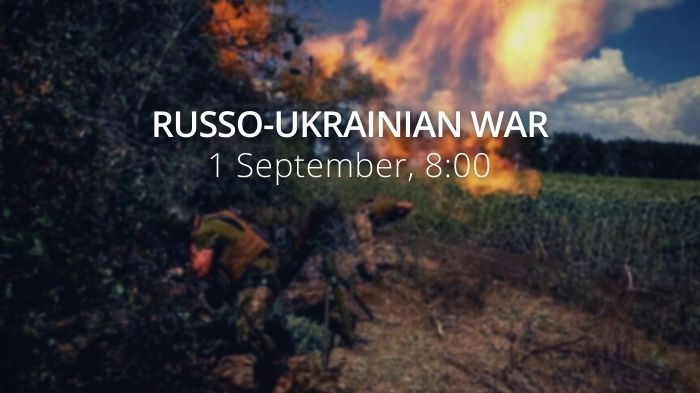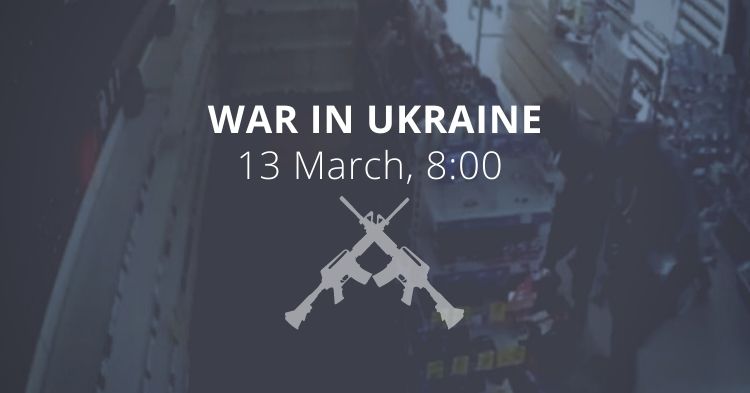Russia began an information operation declaring the Ukrainian counteroffensive a failure almost as soon as it was launched. Russian forces conducted ground attacks near Kharkiv, Bakhmut, Donetsk. The Russian military is concentrating efforts on establishing full control over the territory of the Donetsk Oblast and maintaining the captured areas of Luhansk, Donetsk, Kherson, Kharkiv, Zaporizhzhia, and Mykolaiv Oblasts, while carrying out air and missile attacks on military and civilian objects on the territory of Ukraine. Russian occupation authorities are imposing a curriculum on Ukrainian students aimed at eliminating the notion of Ukrainian national identity. The G7 Non-Proliferation Directors Group condemned Russian attempts to disconnect the Zaporizhzhia Nuclear Power Plant from the Ukrainian power grid as “unacceptable” ahead of the arrival of the (IAEA) delegation to the plant. Ukrainian partisans carried out an assassination on a collaborator in the Zaporizhzhia Oblast.
https://twitter.com/War_Mapper/status/1565133719941398528
The General Staff’s operational update regarding the Russian invasion as of 06.00 am, August 24, 2022 is in the dropdown menu below.
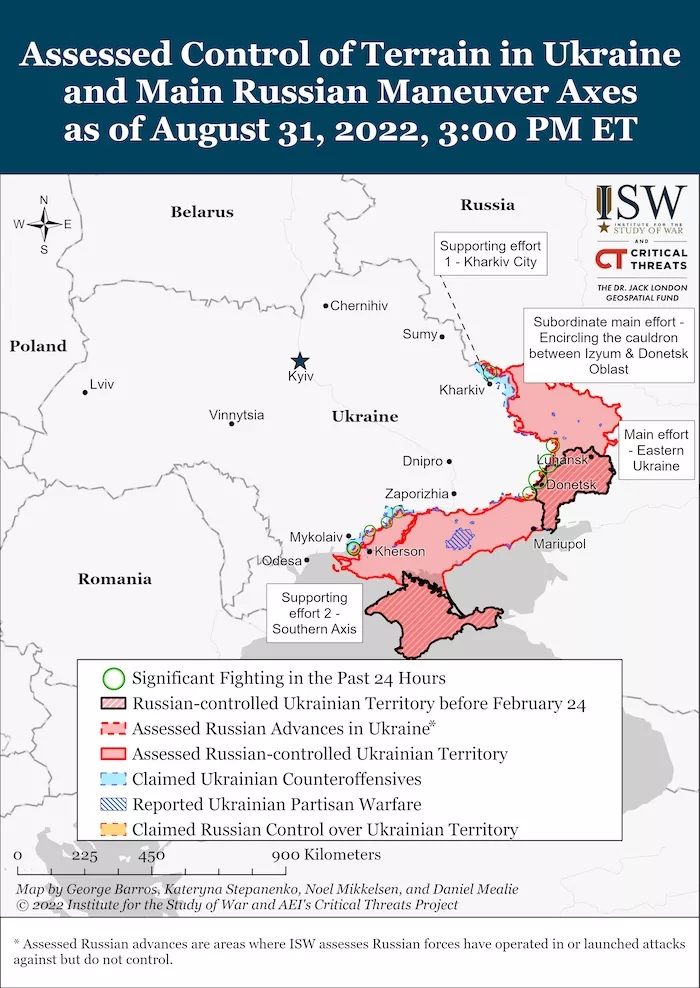
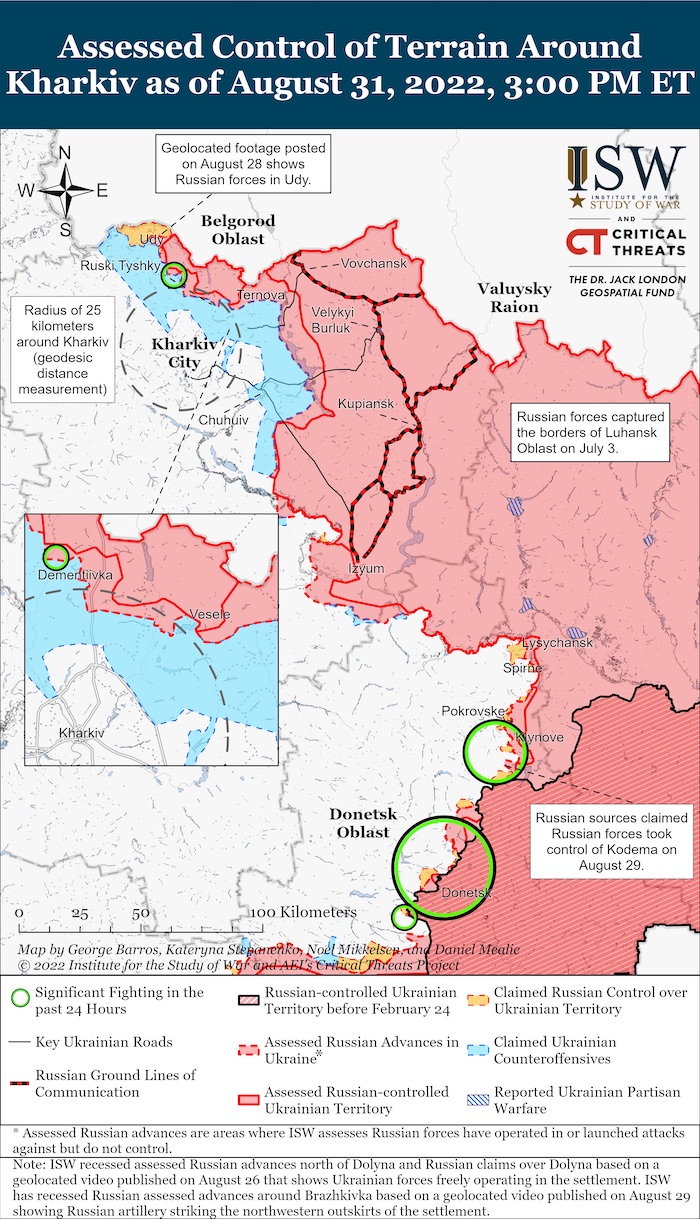
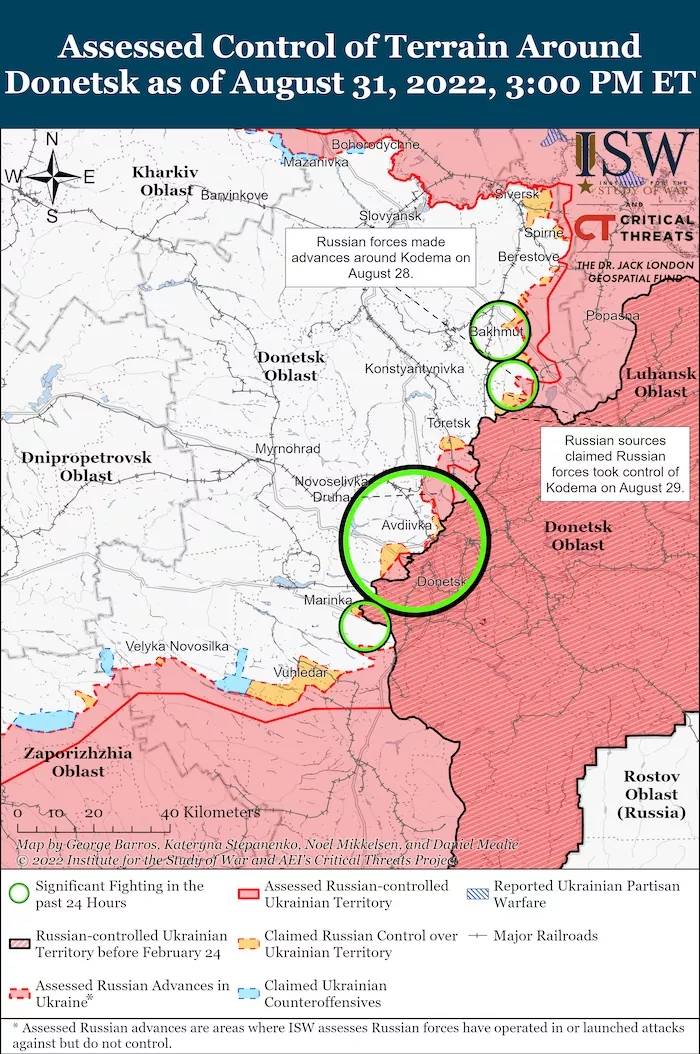
Military Updates
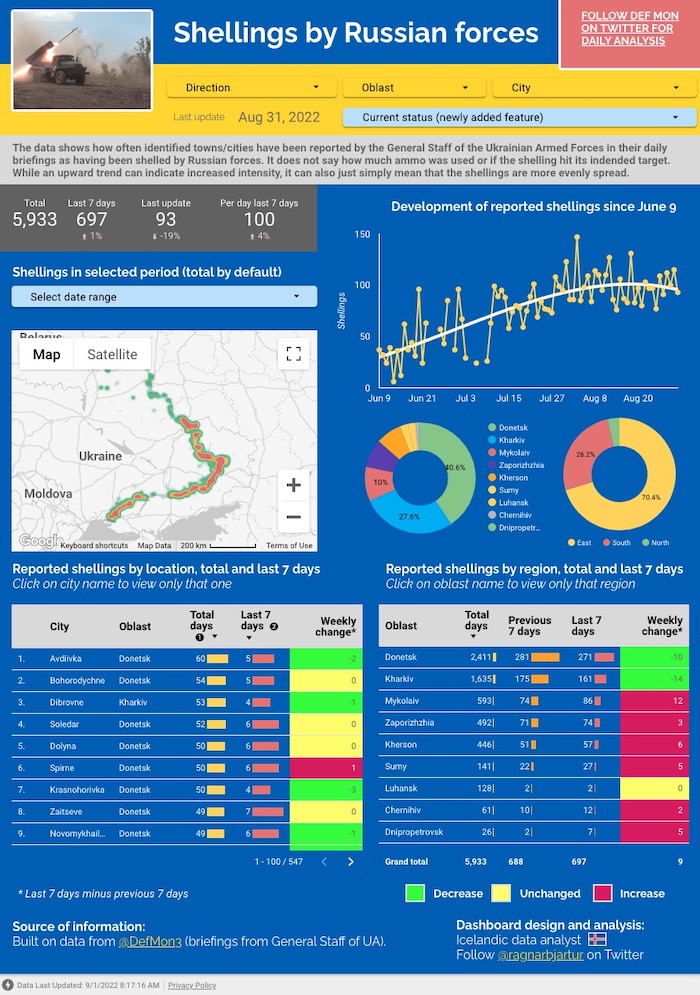
The silence regime on Kherson counteroffensive continues.
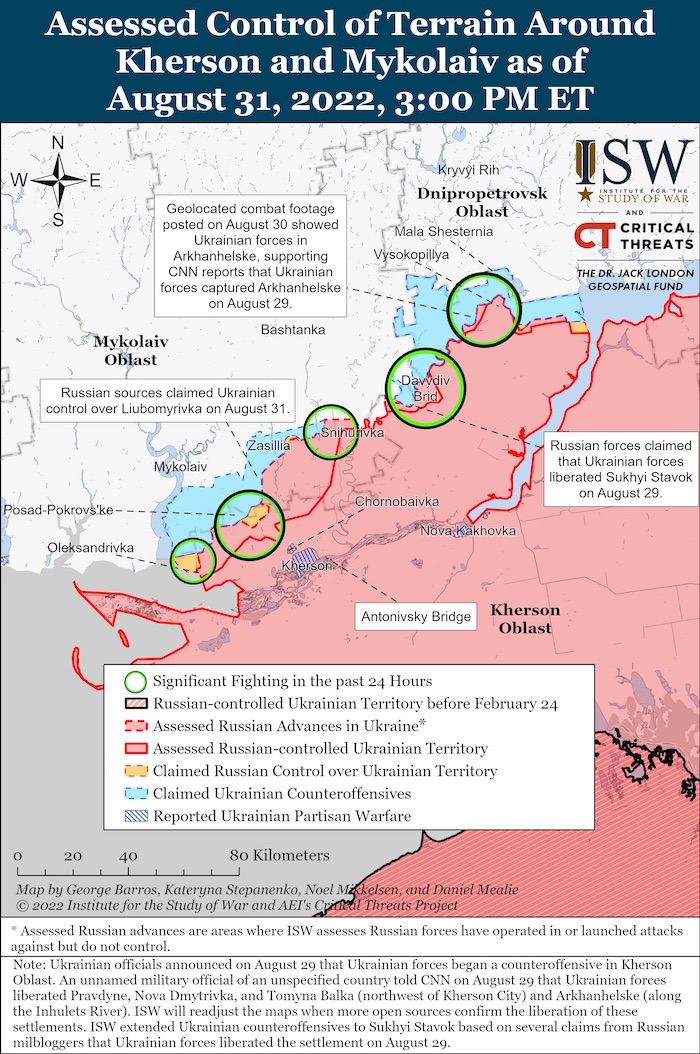
Regional Updates
Russian troops shelled the city of Bakhmut and destroyed a house, killing a woman. The body was removed from the rubble
Also, a Russian missile attack hit directly residential building in the Kharkiv center, where are victims, rescuers & mayor said. https://t.co/48CUORKEUE pic.twitter.com/RFuwMdWtcK
— Euromaidan Press (@EuromaidanPress) August 31, 2022
In the Kharkiv Oblast, the city of Kharkiv under attack again. One of the city's enterprises was on fire.
In the Zaporizhzhia Oblast, Russians are shelling Energodar. The city hall building damaged. The Russian military might be trying to create fakes about alleged shelling from Ukraine in order to disrupt the IAEA inspection to the Zaporizhzhia nuclear power plant.
According to British Defence Intelligence, (last 48 hours):
- Over 30-31 August 2022, Ukrainian Armed Forces continued offensive operations in southern Ukraine, supported by intensive long-range strikes against Russian command and logistics locations across the occupied zone.
- Ukraine’s Ministry of Defence also released video footage of Ukrainian aircraft operating high-speed anti-radiation missiles (HARMs). Russian has previously claimed that it has recovered fragments of these types of weapons, which are designed to locate and destroy radars.
- Russia prioritises strong ground-based air defences - the radar coverage which enables this is a critical capability in its Ukraine operation. A substantial, sustained degradation of Russia’s radars with HARMs would be a major set-back to Russia’s already troubled situational awareness.
Losses of the Russian army
As of 31 August, the approximate losses of weapons and military equipment of the Russian Armed Forces from the beginning of the war to the present day:
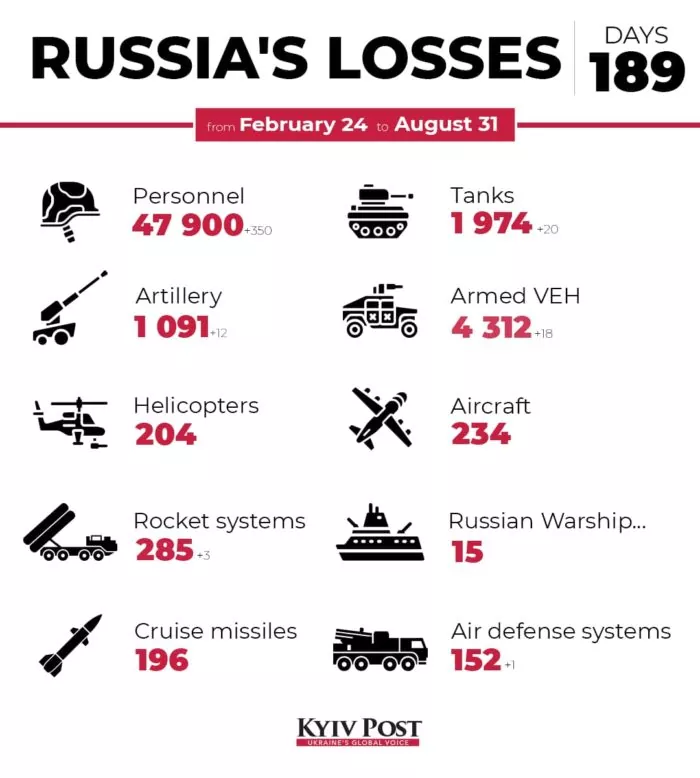
Humanitarian
Russian occupiers try to buy votes before Kherson pseudo-referendum
They offer locals "help" in exchange for giving up their Ukrainian passports and at same time block UA payments to residents,Kakhovka grouping of troops informs adding that few ppl agree https://t.co/cAFIutQsMZ
— Euromaidan Press (@EuromaidanPress) August 31, 2022
️️Environmental
The mission of the International Atomic Energy Agency IAEA set off for the Zaporizhia Nuclear Power Plant from Kyiv to inspect the situation on the facility seized by Russian troops
Occupiers said the visit will take one day contrary to IAEA's chief words https://t.co/k4TBXIizcL
— Euromaidan Press (@EuromaidanPress) August 31, 2022
Ministry of Energy handed over a list of technical and safety indicators to IAEA to be checked during a mission to Zaporizhzhia NPP. “The successful implementation of all tasks by the mission will be of great importance for the nuclear safety not only for Ukraine but for the whole world,” Minister of Energy Herman Galushchenko said. The minister also added that after the de-occupation of the station, an important step will be the creation of a demilitarized zone around it.
Energoatom confirmed that the IAEA mission arrived in the city of Zaporizhzhia. Note: the city is located across the river from the ZNPP. The Russian authorities said they were not going to issue passes for the IAEA mission. A member of the so-called “main council of the military-civilian administration of the Zaporizhzhia region,” Vladimir Rogov, said that the IAEA mission would stand in line to enter the occupied territory. According to Rogov, representatives allegedly could “safely, quickly and without barriers” get to the nuclear power plant from Russia through the occupied territories.
Gazprom will stop the operation of the Nord Stream August 31 -- September 3. The shutdown is reportedly required to carry out maintenance and preventive maintenance on the only operational Trent 60 gas pumping unit.
Legal
https://twitter.com/EuromaidanPress/status/1565062730633170947
The EU will not recognize Russian passports issued in the occupied territories of Ukraine, Vice-President of the European Commission, EU High Representative for Foreign Policy Josep Borrell said. The simplified visa regime with Russia is also suspended. This means that there may be more refusals to issue visas to Russians, the visa price will double, and processing visa will take longer.
EU countries could not agree on a ban on issuing visas to Russians, as many opposed, stated the Hungarian Foreign Minister Peter Szijjarto, noting that his country also did not support this proposal.
EU is likely to make Russians wait longer and pay more for their visas, diplomats say, but is split on travel ban
Eastern, Nordic countries strongly back tourist visa ban and some said they could go for a regional one if there was no agreement at EU level https://t.co/z5DdPnJncB pic.twitter.com/toJVMBionb
— Euromaidan Press (@EuromaidanPress) August 31, 2022
Security Service of Ukraine collected solid evidence of war crimes committed by 3 more Russian soldiers during the occupation of Kyiv Oblast
Residents of 9 villages suffered from criminal orders to carry out artillery shelling of these populated areas https://t.co/SecdA1peVy pic.twitter.com/VTmPQi8Qui
— Euromaidan Press (@EuromaidanPress) August 31, 2022
Support
Canadian government became the first to sanction the directors of 5 Russian state-owned companies that produce missiles, air defense systems, and heavy equipment for the Russian military. https://t.co/7uLOjX4Vkp pic.twitter.com/ucxF1eeMKb
— Euromaidan Press (@EuromaidanPress) August 31, 2022
In August, Ukraine received a record monthly volume of foreign financial assistance in the amount of $4.6 billion, Finance Minister Serhiy Marchenko said. This became possible, in particular, thanks to grant funds provided by the United States through the World Bank in the amount of $3 billion. “We expect $1.5 billion in grant assistance from the US in September - this is the last tranche, and we also expect macro-financial assistance from the EU in September and early October,” the head of the Ministry of Finance said.
Since the beginning of the war, Ukraine has received $17.5 billion from international partners, Prime Minister Denys Shmyhal said. According to him, another 8 billion euros of macro-financial assistance from the EU is expected over the next months.
Swedish Minister of Foreign Affairs announced new military aid for Ukraine with artillery munitions worth $47 mn and said that the provision of Archer artillery and air defense is currently discussed https://t.co/HvG87YTfNn
— Euromaidan Press (@EuromaidanPress) August 31, 2022
New Developments
Gazprom will deliver more natural gas to Hungary
From Sep 1, Gazprom will deliver 5.8 million cubic meters of natural gas per day to Hungary via Serbia, more than stipulated in the long-term contract, Hungarian Foreign Minister wrote https://t.co/fwRJ0k0AWC
— Euromaidan Press (@EuromaidanPress) August 31, 2022
Attempted arson attack targeted a nursery mainly attended by Ukrainian children in Eastern Germany
The State Protection Office has launched an investigation. Unknown suspects tried to set fire to the nursery in Leipzig, nobody was injured https://t.co/uf3rHDdYkk
— Euromaidan Press (@EuromaidanPress) August 31, 2022
Russia begins using conscripts from Moscow & Petersburg at war
So far, only in Crimea, Ukraine's Intelligence wrote. However, unlike in other places where conscripts serve, there is a risk to be killed in Crimea receiving only conscripts' $82 allowance https://t.co/cj1zKbVDRM pic.twitter.com/56f3Kc8DII
— Euromaidan Press (@EuromaidanPress) August 31, 2022
Assessment
- On the war.
The Institute for the Study of War has made the following assessment as of Saturday 23 August, 2022:
Ukrainians and the West should not fall for Russian information operations portraying the Ukrainian counteroffensive in Kherson Oblast as having failed almost instantly or that depict Ukraine as a helpless puppet of Western masters for launching it at this time. The Russian Ministry of Defense began conducting an information operation to present Ukraine’s counteroffensive as decisively failed almost as soon as it was announced on August 29.[1] Several prominent military bloggers—even bloggers who have historically been critical of the Kremlin—are promoting this message.[2] Other milbloggers are additionally promoting the narrative that Ukraine’s Western handlers pushed Ukraine to launch the counteroffensive prematurely and/or too late for “political” reasons and because the West expected a counteroffensive.[3] Kremlin media outlets have also centrally amplified allegations of civil-military conflict between Ukrainian President Volodymyr Zelensky and Ukrainian Commander-in-Chief Valerii Zaluzhnyi to bolster the narrative that Zelensky sought to conduct a counteroffensive for inappropriate political reasons whereas Zaluzhnyi assessed Ukrainian forces were not militarily prepared to do so.[4]
Military operations on the scale of this counteroffensive do not succeed or fail in a day or a week. Ukrainian officials have long acknowledged that they do not have the sheer mass of mechanized forces that would have been needed to conduct a blitzkrieg-like drive to destroy the Russian defenses in Kherson Oblast or anywhere. They have instead been setting conditions for months by attacking and disrupting Russian ground lines of communication (GLOCs), Russian command and control, and Russian logistics systems throughout southwestern occupied Ukraine. The timing of the start of the counteroffensive is consistent with the observed degradation of Russian capabilities in western Kherson Oblast balanced against the need to start liberating occupied Ukrainian lands and people as soon as possible. There is no reason to suspect that the timing has been materially influenced by inappropriate considerations or tensions. Counteroffensive operations now underway will very likely unfold over the coming weeks and possibly months as Ukrainian forces take advantage of the conditions they have set to defeat particular sectors of the line they have identified as vulnerable while working to retake their cities and towns without destroying them in the process.
Military forces that must conduct offensive operations without the numerical advantages normally required for success in such operations often rely on misdirections and feints to draw the defender away from the sectors of the line on which breakthrough and exploitation efforts will focus. The art of such feints is two-fold. First, they must be conducted with sufficient force to be believable. Since they are feints, however, rather than deliberate attacks expected to succeed, they often look like failures—the attacking units will fall back when they feel they have persuaded the defender of their seriousness. Second, they take time to have an effect. When the purpose of the feint is to draw the defender’s forces away from the intended breakthrough sectors, the attacker must wait until the defender has actually moved forces. There will thus likely be a delay between the initial feint operations and the start of decisive operations. The situation during that delay may well look like the attack has failed.
The Ukrainian military and government are repeating requests to avoid any reporting or forecasting of the Ukrainian counteroffensive, a measure that is essential if the counteroffensive includes feints or misdirections.[5] It is of course possible that the counteroffensive will fail, that any particular breakthrough attempt that fails was not a feint, or that the Ukrainian military has made some error in planning, timing, or execution that will undermine the success of its operations. But the situation in which Ukraine finds itself calls for a shrewd and nuanced counteroffensive operation with considerable misdirection and careful and controlled advances. It is far more likely in these very early days, therefore, that a successful counteroffensive would appear to be stalling or unsuccessful for some time before its success became manifest.
ISW and other analysts studying this war have been appropriately cautious and circumspect in announcing the culmination or defeat of major Russian offensive operations. ISW will apply the same caution and circumspection to assessing the progress of the Ukrainian counteroffensive and exhorts others to do the same.
Russian authorities released a list of the locations of schools in occupied areas, including precise coordinates, ostensibly warning of possible Ukrainian attacks against them as the school year begins on September 1. This announcement could be preparation for Russian false-flag attacks on schools, for an explanation of very low attendance, or for some other purpose. The Russian Defense Ministry (MoD) issued a statement on August 31 warning that Ukrainian forces are preparing to shell schools in occupied Donetsk, Luhansk, Kharkiv, Kherson, and Zaporizhzhia oblasts.[6] The Russian MoD released a list of the addresses and exact locations of all schools in occupied areas of Ukraine under the pretext of “ensuring the safety of students and teachers.”[7] This statement, along with the list of schools in occupied areas, could be an attempt to set information conditions for three potential courses of action on September 1. The first, and most dangerous, may be a preparation for Russian troops to stage a false-flag attack against educational infrastructure in occupied areas of Ukraine and blame the Ukrainian armed forces for the attack. The second scenario, which is more likely, is that Russian authorities may be setting conditions to explain very low enrollment and attendance in Russian-run schools as the school year begins. As ISW reported on August 30, Ukrainian families with children have been increasingly leaving Russian-occupied areas of Ukraine as the school year approaches.[8] Russian authorities may seek to amplify the claimed threat of Ukrainian strikes against schools in order to explain low attendance levels. The third scenario is that Russian authorities could be attempting to establish a published no-strike list by identifying specific civilian infrastructure, which will later allow them to use the identified schools as military bases with the expectation that Ukrainian forces will not target designated civilian infrastructure.
Russian authorities are additionally using the start of the new school year to escalate efforts to institutionalize the elimination of Ukrainian identity. Russian authorities continued to disseminate Russian educational materials in schools in occupied areas of Ukraine. Russian-backed authorities from Sevastopol arrived in Starobilsk, Luhansk Oblast, to deliver backpacks and official state symbols of the Russian Federation to local schools.[9] The Russian-appointed head of Crimea, Sergey Aksyonov, similarly called on educators in Crimea to intensify patriotic programming in Crimean schools, notably to teach children about Russian President Vladimir Putin’s decision to conduct a “special military operation” in Ukraine.[10] Ukrainian outlet Strana reported that the first lesson that will be taught in schools in occupied Donetsk and Luhansk oblasts is oriented on a lesson outline that pulls from Putin’s article on “The Historical Unity of Russians and Ukrainians”, his speeches on the recognition of the Donetsk and Luhansk People’s Republics (DNR and LNR), and the commencement of the "special military operation.”[11] In these speeches, Putin rejected the legitimacy of Ukrainian identity, declaring that it “is entirely the product of the Soviet era... shaped on the lands of historical Russia.”[12] He also repeatedly declared that Ukraine is part of Russia and cannot be a state in its own right. The explicit link between Russian-imposed curricula in Ukrainian schools and these speeches and writings is part of an effort to erase the Ukrainian identity in Russian-occupied parts of Ukraine through educational control.[13]
The G7 Non-Proliferation Directors Group stated that Russian attempts to disconnect the Zaporizhzhia Nuclear Power Plant (ZNPP) would be “unacceptable,” ahead of the International Atomic Energy Agency (IAEA) delegation’s visit to the plant.[14] The G7 Non-Proliferation Directors Group noted that the ZNPP should not be used for military activities or the storage of military material. Satellite imagery provided by Maxar previously showed Russian combat vehicles sheltering under the ZNPP infrastructure very close to a reactor vessel.[15]
Russian and Ukrainian sources again exchanged accusations of shelling and loitering munition strikes on Enerhodar on August 31. Kremlin-sponsored sources claimed that Ukrainian forces conducted an unmanned aerial vehicle (UAV) strike on the Enerhodar City Council building, and Ukrainian officials stated that Russian forces shelled the building in an effort to frame Ukrainian forces ahead of the IAEA visit.[16]
Key Takeaways
- The Russian Ministry of Defense and Russian milbloggers began an information operation declaring the Ukrainian counteroffensive a failure almost as soon as it was launched. It is far too soon to assess the progress of the counteroffensive operation, however, which will likely be difficult to evaluate in the short term if it relies on feints and misdirection.
- Russian occupation authorities are imposing a curriculum on Ukrainian students aimed at eliminating the notion of Ukrainian national identity, explicitly in line with Russian President Vladimir Putin’s speeches and writings falsely claiming that Ukraine is part of Russia, and that the Ukrainian identity was an invention of the Soviet period.
- The G7 Non-Proliferation Directors Group condemned Russian attempts to disconnect the Zaporizhzhia Nuclear Power Plant from the Ukrainian power grid as “unacceptable” ahead of the arrival of the International Atomic Energy Agency (IAEA) delegation to the plant.
- Russian forces conducted a limited ground attack north of Kharkiv City.
- Russian forces conducted ground attacks south of Bakhmut and along the western outskirts of Donetsk City.
- Russian-appointed officials in Crimea began “reconstructing” air defense systems to counter smaller targets in response to recurring drone attacks on the peninsula. Russian officials are likely strengthening Crimean air defenses at the expense of other theaters.
- Zabaykalsky Krai announced the formation of the “Daursky” volunteer engineer-sapper battalion.
- Ukrainian partisans conducted an improvised explosive device (IED) attack against the headquarters of the “Together with Russia” political organization in Berdiansk, Zaporizhzhia Oblast, where occupation authorities were reportedly preparing for sham referenda.

